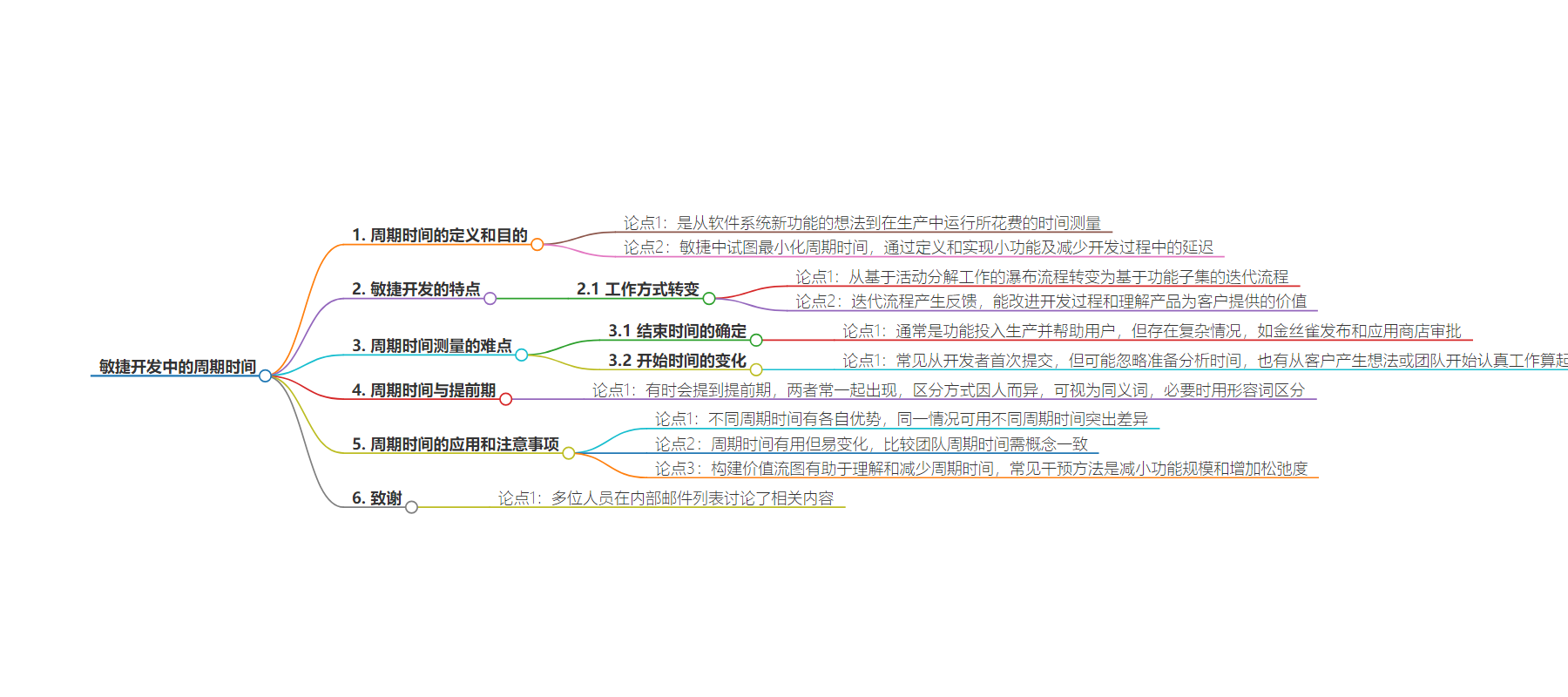包阅导读总结
1. 关键词:Cycle Time、Agile、Software Development、Feedback、Minimize
2. 总结:本文主要介绍了软件系统中 Cycle Time 的概念,即从新功能的想法到投入生产的时间,强调在敏捷开发中应尽量减少它。但 Cycle Time 的起止时间衡量存在多种方式和困难,需谨慎对比不同团队的 Cycle Time。理解工作流以减少它是有益的。
3. 主要内容:
– Cycle Time 概念
– 衡量软件系统新功能从想法到生产运行的时间。
– 敏捷开发中的 Cycle Time
– 从瀑布流程转向迭代流程,产生反馈环。
– 敏捷重视快速让功能通过工作流投入生产。
– Cycle Time 的测量难题
– 停止时间:投入生产并帮助用户,但情况复杂。
– 开始时间:有多种标记方式,差异大。
– 与 Cycle Time 相关的概念
– 还有“phase lead time”,但区分方式不一致。
– 结论
– Cycle Time 有用但难统一衡量,需谨慎对比。
– 构建价值流图理解工作流以减少 Cycle Time 是有益的。
思维导图:
文章地址:https://martinfowler.com/bliki/CycleTime.html
文章来源:martinfowler.com
作者:Martin Fowler
发布时间:2024/9/4 4:00
语言:英文
总字数:831字
预计阅读时间:4分钟
评分:90分
标签:敏捷 开发,周期时间,软件 度量,迭代 过程,功能 开发
以下为原文内容
本内容来源于用户推荐转载,旨在分享知识与观点,如有侵权请联系删除 联系邮箱 media@ilingban.com
Cycle Time is a measure of how long it takes to get a new feature in a software system from idea to running in production. In Agile circles, we try to minimize cycle time. We do this by defining and implementing very small features and minimizing delays in the development process. Although the rough notion of cycle time, and the importance of reducing it, is common, there is a lot of variations on how cycle time is measured.
A key characteristic of agile software development is a shift from a Waterfall Process, where work is decomposed based on activity (analysis, coding, testing) to an Iterative Process where work is based on a subset of functionality (simple pricing, bulk discount, valued-customer discount). Doing this generates a feedback loop where we can learn from putting small features in front of users. This learning allows us to improve our development process and allows us to better understand where the software product can provide value for our customers.
This feedback is a core benefit of an iterative approach, and like most such feedback loops, the quicker I get the feedback, the happier I am. Thus agile folks put a lot of emphasis on how fast we can get a feature through the entire workflow and into production. The phrase cycle time is a measure of that.
But here we run into difficulties. When do we start and stop the clock on cycle time?
The stopping time is the easiest, most glibly it’s when the feature is put into production and helping its users. But there are circumstances where this can get muddy. If a team is using a Canary Release, should it be when used by the first cohort, or only when released to the full population? Do we count only when the app store has approved its release, thus adding an unpredictable delay that’s mostly outside the control of the development team?.
The start time has even more variations. A common marker is when a developer makes a first commit to that feature, but that ignores any time spent in preparatory analysis. Many people would go further back and say: “when the customer first has the idea for a feature”. This is all very well for a high priority feature, but how about something that isn’t that urgent, and thus sits in a triage area for a few weeks before being ready to enter development. Do we start the clock when the team first places the feature on the card wall and we start to seriously work on it?
I also run into the phase lead time, sometimes instead of “cycle time”, but often together – where people make a distinction between the two, often based on a different start time. However there isn’t any consistency between how people distinguish between them. So in general, I treat “lead time” as a synonym to “cycle time”, and if someone is using both, I make sure I understand how that individual is making the distinction.
The different bands of cycle time all have their advantages, and it’s often handy to use different bands in the same situation, to highlight differences. In that situation, I’d use a distinguishing adjective (e.g. “first-commit cycle time” vs “idea cycle time”) to tell them apart. There’s no generally accepted terms for such adjectives, but I think they are better than trying to create a distinction between “cycle time” and “lead time”.
What these questions tell us is that cycle time, while a useful concept, is inherently slippery. We should be wary of comparing cycle times between teams, unless we can be confident we have consistent notions of their stop and start times.
But despite this, thinking in terms of cycle time, and trying to minimize it, is a useful activity. It’s usually worthwhile to build a value stream map that shows every step from idea to production, identifying the steps in the work flow, how much time is spent on them, and how much waiting between them. Understanding this flow of work allows us to find ways to reduce the cycle time. Two commonly effective interventions are to reduce the size of features and (counter-intuitively) increase Slack. Doing the work to understand flow to improve it is worthwhile because the faster we get ideas into production, the more rapidly we gain the benefits of the new features, and get the feedback to learn and improve our ways of working.
Acknowledgements
Andrew Harmel-Law, Chris Ford, James Lewis, José Pinar, Kief Morris, Manoj Kumar M, Matteo Vaccari, and Rafael Ferreira discussed this post on our internal mailing list
